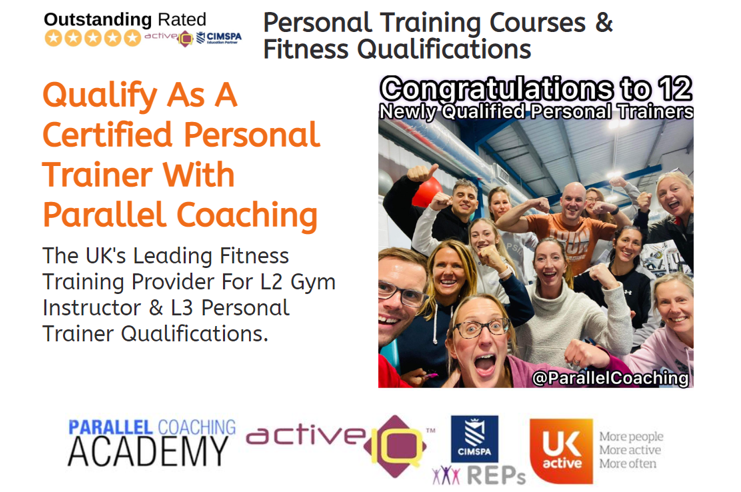If you’re thinking about becoming a PT, you might be wondering how challenging the Level 3 Personal Training course really is. Many aspiring PTs worry about passing the assessments, mastering the practical skills, and understanding the theory.
While the course is demanding, it’s designed to prepare you thoroughly for a real-world career in fitness. With the right guidance and hands-on practice, you can confidently succeed and step into the industry ready to coach clients safely and effectively.
Here are five key aspects of the Level 3 Personal Training course that learners often find challenging and how to approach them:
1. Understanding Anatomy and Physiology
The course requires a strong grasp of the human body, including muscles, joints, and energy systems. You’ll need to understand how the body moves, how it adapts to exercise, and how to design safe programs for different clients. Learning Anatomy and Physiology can feel overwhelming at first, but it can be made easier by revising more effectively.
The key to avoiding Anatomy revision overwhelm is to study in a way that suits your learning style; that’s why our Revision Bootcamps include video, audio downloads, mock questions, acronyms and imagery. Our revision boot camps have helped over 10,000 learners pass their anatomy exams (many are studying with other training providers); and they are included in the Parallel Coaching PT course.
2. Practical Coaching Skills In Our Milton Keynes Classroom
You’ll be assessed on your ability to coach exercises safely and effectively. This includes spotting technique errors, cueing clients clearly, and adjusting programs in real-time. Hands-on practice in a supervised environment is essential to building confidence and competence. This is why we teach our PT courses using a blended-learning model; that is, you do some work at home, but all coaching skills are learned face-to-face in our Milton keynes classroom.
3. Client Assessment and Program Design
Level 3 Personal Trainers must be able to assess a client’s fitness, goals, and limitations, then create personalised programs. This requires applying theory to real-world scenarios and thinking critically about progression, adaptation, and safety. It can be complex, but repeated practice and feedback help learners get it right. Our Level 3 Personal Trainer course makes this easy in three parts:
- Consultation and measurements are taught and practised in the classroom, so that when you do a real-life client session, it isn’t the first time youve done it.
- You will complete a casestudy with a friend/ client where you can practice the full client journey, including planning for a goal, and get feedback on it.
- Lifetime access to your training videos means you can rewind any areas you are stuck on, whenever you like (including periodisation, training systems, and even session timings).
4. Passing Assessments
The course includes both practical and theoretical assessments, such as client sessions, written assignments, and multiple-choice exams. Many learners worry about passing, but consistent study, revision, and hands-on experience ensure you are prepared. The key is to approach each assessment methodically and apply what you’ve practised.
Also, many Personal Trainer courses make the practical assessment logistically difficult by asking you to submit a video of your instructing. On our PT course, you will do your assessment face-to-face on the training weekends, with no need to video yourself.
5. Time Management and Study Commitment
The Level 3 Personal Training course demands commitment outside the classroom as well as during practical sessions. Balancing revision, coursework, and practical practice can be challenging, especially if you’re working or have other commitments. Planning your time effectively and using structured study methods makes the workload manageable and increases your chances of success.
We will help you with this by giving you example revision timetables that you can adapt to suit you.
These challenges are why face-to-face, practical learning is so important. Our courses allow learners to practise coaching, program design, and client assessments in a safe, supervised environment. This hands-on approach lets you make mistakes, receive feedback, and refine your skills — something online learning alone cannot replicate. Level 3 PT training course is a vocational, accredited and in-person experience that ensures you leave with the confidence, knowledge, and practical ability to succeed in real gyms.
Summary
The Level 3 Personal Training course is challenging, but entirely achievable with the right approach. You’ll develop knowledge of anatomy and physiology, practical coaching skills, client assessment and program design, and pass theory and practical assessments. Hands-on learning is key to building confidence and competence, preparing you for a successful career as a personal trainer.
If you’re ready to take the next step, find out more about our upcoming Level 3 Personal Training courses at our Milton Keynes Academy and start your journey to becoming a confident, qualified PT.
Qualify as a Personal Trainer
This is the fitness industry’s GOLD standard qualification to kick start a career in health and fitness & start training clients 121 and in small groups.
Find out more about our Personal Training course here >>
https://courses.parallelcoaching.co.uk/products/become-a-personal-trainer

Want to learn more about becoming a personal trainer?
Watch our free 4-part video series answering all common questions and showing you all the details
Dedicated to More
Hayley “Level 3 Personal Training Course in Milton Keynes” Bergman
Parallel Coaching
P.S. You can also find us on the following platforms:
Instagram: https://www.instagram.com/parallelcoaching
Facebook: https://www.facebook.com/ParallelCoaching
YouTube: http://bit.ly/2F1Z1bs
Read more blogs about becoming a PT: HERE
TrustPilot Reviews: HERE
Sources
- British Journal of Sports Medicine (2019). Effective methods for personal trainer education and assessment.
- Chartered Institute for the Management of Sport and Physical Activity (CIMSPA) – Professional Standards: Personal Trainer
- UK Government – National Occupational Standards for Personal Training

